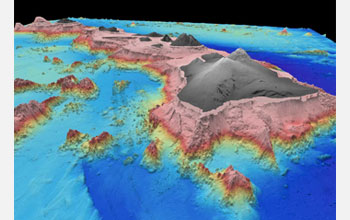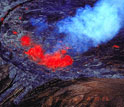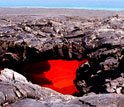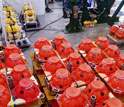News Release 09-232
Scientists Locate Deep Origins of "Hawaiian Hotspot"
Sea-floor seismometers open window into Earth's mantle beneath Hawaiian Islands

The topography of the Hawaiian Islands is shown in 3-D.
December 3, 2009
This material is available primarily for archival purposes. Telephone numbers or other contact information may be out of date; please see current contact information at media contacts.
The Hawaiian Islands are one of the outstanding volcanic features on Earth, but their origins have been shrouded in mystery.
Still in debate has been a theory proposed 40 years ago, which states that mid-tectonic plate hotspots such as Hawaii are generated by upwelling plumes of lava from the base of Earth's lower mantle.
Cecily Wolfe, a geologist at the University of Hawai‘i at Mânoa School of Ocean and Earth Science and Technology, and a multi-institutional team of scientists put the theory to the test.
Their research findings will be published in this week's issue of the journal Science.
A deployment of a large network of sea-floor seismometers in Hawai‘i, through a National Science Foundation (NSF)-funded expedition called the Plume-Lithosphere Undersea Melt Experiment (PLUME), opened up a window into the Earth.
PLUME alllowed scientists to obtain the best picture yet of a mantle plume originating from the lower mantle, and revealed Hawai‘i's deep roots.
"The hypothesis that hot spots like Hawaii originate from mantle plumes is one of the longest-standing and most controversial topics in geology," says Robert Detrick, director of NSF's Division of Earth Sciences and a co-author of the paper. Detrick conducted the research while at the Woods Hole Oceanographic Institution
"This pioneering experiment combining large numbers of broadband seismometers on the seafloor with instruments on land has provided the most persuasive evidence yet for the existence of a mantle plume extending into the lower mantle beneath Hawaii."
The project involved four oceanographic research cruises to deploy and recover ocean bottom seismometers at 73 sites, led by Gabi Laske of the Scripps Institution of Oceanography and John Collins of the Woods Hole Oceanographic Institution.
Sean Solomon of the Carnegie Institution for Science provided a concurrent deployment of land seismometers on the main Hawaiian Islands.
The large, 1,000-km wide seafloor network yielded unprecedented results in a remote oceanic region.
The seismometers were used to record the timing of seismic shear waves from large earthquakes (magnitudes greater than 5.5) around the world.
This information was used to determine whether seismic waves travel more slowly through hot rock as they pass beneath Hawai‘i.
Combining the timing measurements from earthquakes recorded on many seismometers allowed Wolfe and colleagues to construct a sophisticated 3-dimensional image of the Hawaiian mantle.
In the upper mantle, the Hawaiian Islands are underlain by low shear-wave velocities, linked with hotter-than-average material from an upwelling plume.
Low velocities continue down into the Earth's transition zone, at 410 to 660 km depth, and extend even deeper into the Earth's lower mantle down to at least 1,500 km depth.
The location of the Hawaiian Islands in the middle of the Pacific Ocean had hampered past efforts to resolve its deep structure.
Seismometer deployments limited to land sites on the islands did not provide sufficient coverage for high-resolution imaging, and Hawaii is also far from the most active circum-Pacific zones of earthquakes.
As a result, scientists turned to a more technologically challenging, marine approach by placing temporary instrumentation on the seafloor to record seismic waves.
Results of the project make a strong case for the existence of a deep mantle plume, with implications not just for Hawaii, but for how convection in the solid Earth works; the Earth's composition with depth; and the inner Earth's evolution.
"This experiment was first conceived by our team a decade ago," says Wolfe. "The results have been worth the wait and exceeded all expectations. The success of such an ambitious seafloor experiment is a technological feat in itself, and signals a new era in the field of marine seismology."
Has the question of hot spots and mantle plumes been settled at last?
"It's a very strong vote," says Solomon, "in favor of the plume model."
-NSF-
-
Lava splatters near the coastal entry of Kilauea.
Credit and Larger Version -
A lava flow type called pahoehoe--smooth, unbroken lava--at Kilauea.
Credit and Larger Version -
Aerial photo of Puu Oo cinder-and-spatter cone on the east rift zone of Kilauea.
Credit and Larger Version -
This photo shows a "lava skylight" at Kilauea.
Credit and Larger Version -
An ocean-bottom seismometer package: green = seismometer, yellow = acquisition system.
Credit and Larger Version -
On deck are the components of the seismometer acquisition packages.
Credit and Larger Version -
The researchers' findings appear in the December 4, 2009, issue of the journal Science.
Credit and Larger Version
Media Contacts
Cheryl Dybas, NSF, (703) 292-7734, email: cdybas@nsf.gov
Tara Hicks Johnson, University of Hawaii, (808) 956-3151, email: hickst@hawaii.edu
Alan Cutler, Carnegie Institution for Science, (202) 939-1142, email: acutler@ciw.edu
The U.S. National Science Foundation propels the nation forward by advancing fundamental research in all fields of science and engineering. NSF supports research and people by providing facilities, instruments and funding to support their ingenuity and sustain the U.S. as a global leader in research and innovation. With a fiscal year 2023 budget of $9.5 billion, NSF funds reach all 50 states through grants to nearly 2,000 colleges, universities and institutions. Each year, NSF receives more than 40,000 competitive proposals and makes about 11,000 new awards. Those awards include support for cooperative research with industry, Arctic and Antarctic research and operations, and U.S. participation in international scientific efforts.
Connect with us online
NSF website: nsf.gov
NSF News: nsf.gov/news
For News Media: nsf.gov/news/newsroom
Statistics: nsf.gov/statistics/
Awards database: nsf.gov/awardsearch/
Follow us on social
Twitter: twitter.com/NSF
Facebook: facebook.com/US.NSF
Instagram: instagram.com/nsfgov









